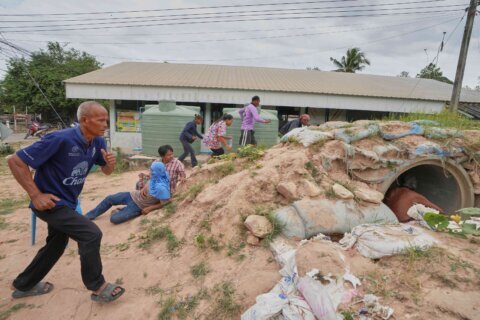Jamie Slater, special to WTOP.com
WASHINGTON – The enduring cold snap has at least given the area a great conversation starter. “It’s so cold that…”
This year, the rest of that sentence may be “the Chesapeake Bay Mainstem froze.”
At the Chesapeake Bay, temperatures have dropped below freezing and ice is beginning to form.
That means the Chesapeake Bay Mainstem may freeze for the first time in more than 20 years, according to a tweet Friday morning from Steve Vilnit, director of fisheries marketing for the Maryland Department of Natural Resources.
Chesapeake Bay temps have dropped below freezing. This may be the first time in over 20 years that the mainstem freezes. #WalkTheBay
— Steve Vilnit (@SteveVilnit) January 24, 2014
Although the water is around the freezing point of 32 degrees now, salt water freezes at lower temperatures, according to Mark Trice, program manager for water quality programs at the Maryland Department of Natural Resources. But these could come next week.
“Looking at what the forecasts are with very low temperatures headed into next week, I would expect that we would see some surface ice around the Bay Bridge,” he said. “How thick I can’t say, but it’s not something that’s that unusual. We saw similar conditions back in 2004 and also some ice cover back in 2011.”
The freeze will seem mild in comparison to the last event of this kind, though.
“I don’t think this is going to be as bad as the biggest freeze that we had in our generation, which was back in 1976-1977 when we had ice covers that ranged from the Susquehanna River all the way down to the Pawtuxet River,” he said.
“The ice during that time period was so thick around the Bay Bridge you can find photos online where people are out on the water skating, taking vehicles out on the ice and pulling sleds, and water men were held up from getting out of port for weeks, if not a month,” he said. This year, only the Mainstem Bay, which is the main part of the Bay excluding tributaries and rivers, is expected to freeze.”
The temperatures will not affect most wildlife species, Trice said. If the water grows too shallow in the Susquehanna Flats below where the Susquehanna River dumps into the Bay, some plants could be affected.
“Historically that’s a large area of submerged aquatic vegetation or bay grasses. If that water were to freeze from surface to bottom, when that ice dislodges it can create scouring that could affect some of those beds and their distributions this coming year,” he said. If the temperatures drop too low, he said, “Severe drops in temperature can affect temperature-sensitive species such as spot croaker.”
To keep track of the water quality, visit Eyes on the Bay or follow @eyesonthebay on Twitter.






